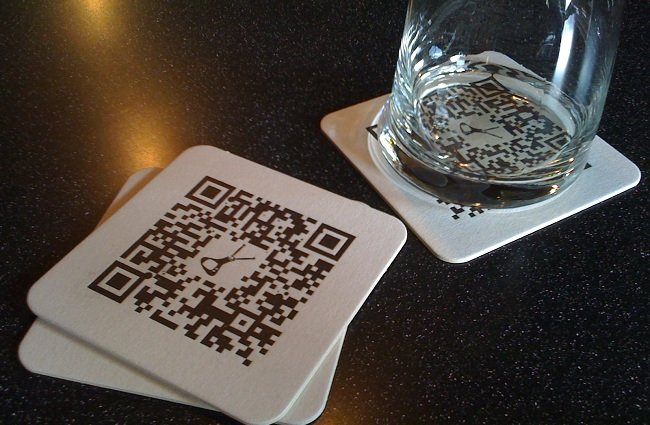Hello Sailor, Goodbye QR - death to tech soothsayers

Through a drunken tale of kebabs and technology, the truth behind QR codes is exposed
At 3 AM Sunday morning I found myself stumbling up Cuba St, clutching a kebab, when I spotted a large QR code glaring at me from a poster. Inebriated to the point of fascination, despite the cold Wellington night, I fished my phone out of my pocket and awkwardly navigated the process of scanning the code.Unlock phone, swipe through apps - going past the QR reader app icon a few times before alighting on it, squat down on the pavement and teeter with hands full of phone and kebab, try and position the code in my camera's view well enough to successfully scan.Job done, other late-night revellers jostle past me while I stare dumbly at my phone waiting for the code to activate something. It's a little too long before I realise I need to make an additional click to actually load the web address that it decoded from the QR.And… Hello Sailor! It is only then that I look around the edges of the QR code and see that my promised destination was shown on the poster, if not that clearly, to be a download of a new Hello Sailor tune.At this point getting my kebab safely home so I could spill it on myself in privacy became more of a priority… Hello Sailor are so not my thing.The next morning I open up my phone, as I idly pick pieces of kebab out of my beard, and find the QR app launched. Recalling, at least some of, the night's events I have another look at the Hello Sailor QR code. They'd avoided my pet-peeve pitfalls - the landing page was mobile friendly with a simple set of actions and succinct content, the song download was by submitting your email not a direct download to the phone over potentially costly 3G.But, but, but…it was Hello Sailor. That overly long-in-the-tooth band who have been touring pubs for decades with about as much relevance to most as that latest Playstation release has to your Grandma.To be clear, I really only scan QR codes when drunk. Most people don't scan them at all.If you follow the narrowing funnel of engagement - upfront you lose the near majority of kiwis who don't have smartphones, then the great majority who don't have a QR reader installed even if they do have a smartphone, then those who aren't comfortable being seen interacting with advertising in public, and finally those who can't reach down, up or around to snap the QR on camera easily.Then there's the fact that most advertisers who have used QR codes to date have failed to describe what the QR code will deliver, create mobile specific landing pages, or give anything really appropriate and compelling as an experience for engaging with them when out & about.But it wasn't any of these things that irked me in this case - it was that Hello Sailor using a QR proved once and for all that QR give no cutting-edge cred to an advertiser. And that was all the value QRs ever really provided.Because at the end of the day, QR codes are simply a way to quickly type a URL into a browser.They're not runes that can only be scribed by wizened old wizards. They don't unlock a mythical wonderland - they just point to whatever website you choose. For a while there they seemed a little magical because they grew to popularity in mobile-friendly Japan and the process of using them was confusing enough to make it seem like, "something amazing must be going on to warrant all those dots and all this effort". In the same way that viewing your first website in the '90s seemed miraculous no matter how underwhelming the content.So, briefly, they imbued an advertisement with some intrigue and the brand with some added sense of relevance. But now they are just saying a brand is trying a little too hard to be "down with the kids" and leave an advertiser feeling satisfied they've done more than they really have.It's like showing your website or product on an iPad in your advert. You might feel bleeding edge, but you're probably just bleeding budget on an ineffective advert.The problem isn't a poor understanding of what QR codes are. It is endemic to the use of any digital in marketing - falling for the hype of technology specialists - who use acronyms and tech-speak to maintain their position.Social media, SEO, QR... Simple rule of thumb: search Google for "[topic] guru" - if a bunch of results from individual's professional profiles are returned you're probably in danger of having the truth obfuscated away from you.If you don't understand how a technology works then don't use it. You understand your customers, and the fundamental principles of good marketing (right?), don't let someone who won't admit to how simple a technology is tell you how to do your job.If the content and experience is good enough, you won't need to trick people into visiting it. By all means give multiple options for accessing it. But if one of those is QR, make it attractive and integrated into the design - not a piece of black & white bling.QR codes have some uses - particularly within apps for differentiating between multiple calls to action. Or as a way of choosing from a set of destinations rather than one. At least until image recognition is good enough to recognise ads, objects, logos without needing a marker. It actually already is. Check out Google search on Android.I can't wait till 2014 when I can have this same rant about Near Field Contact (NFC) in advertising.Users want a kebab, not the queue. QR Codes are dead. Long live the URL.
